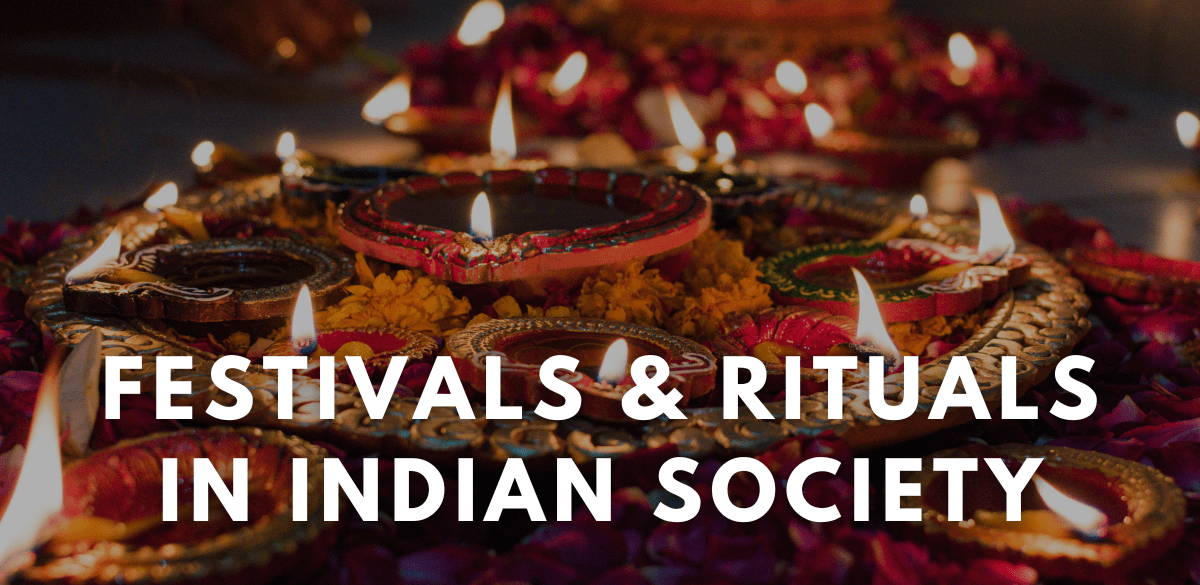The Gandhara region, situated at the crossroads of ancient civilizations, has a rich and diverse artistic legacy that has long captivated scholars and art enthusiasts. Gandhara art flourished during the early centuries of the Common Era and is renowned for its unique blend of Buddhist iconography and Greco-Roman artistic traditions.
The Gandhara School of Art was one of the most significant art schools in ancient Indian history. Although Indian history integrates it, scholars distinctly associate it with the Greco-Bactrian art style. Greco-Bactrian art thrived primarily in Afghanistan and present-day northwestern India, with prominent centers including Taxila, Peshawar, Begram, and Bamiyan. Experts generally consider the Gandhara school of art to have flourished from the 1st century BCE to the 4th century CE.
Table of Contents
Origin and Historical Evidence
According to historian Abdur Rasool, the region that is now Pakistan was the origin of the Gandhara Civilization, which emerged shortly after Alexander the Great’s arrival in 325 BC. This area also witnessed Alexander’s first military defeat at the hands of Raja Porus of Jhelum. Over the years, Gandhara underwent several political takeovers by Persian and Greek powers.
Various Power Structures
After Alexander the Great’s death in 323 BC, his vast empire fell apart quickly. This allowed Indian princes to regain their independence. During this turbulent period, Chandragupta Maurya, from the Magadha royal family, seized control of a large part of northwest India. Over time, he overthrew the Nanda dynasty in Magadha and became the ruler of Hindustan. Chandragupta reigned for 25 years before passing the throne to his son Bindusara in 298 BC. Like his father, Bindusara maintained friendly relations with the Greek rulers of the West, including the Seleucid dynasty, cemented through a marriage alliance after Chandragupta’s victory over the Greeks in battle.
People consider Ashoka, Chandragupta’s grandson, who became king in 272 BC, to be one of ancient India’s most capable and enlightened rulers. After witnessing the horrors of war, Ashoka embraced Buddhism and made it the state religion, even though the people were reluctant. However, Ashoka’s death marked the beginning of the Mauryan Empire’s decline.
As historian V. Smith explains, the Indus Valley then came under the rule of the Greek rulers of Bactria, though they struggled to maintain control of the region. In the mid-2nd century AD, a new powerful group emerged in Central Asia—the Yuezhi, a nomadic and warlike people. They rapidly expanded westward, ending the Greek Kingdom of Bactria that had existed since Alexander the Great’s conquests.
This marked another pivotal moment in the region’s history, underscoring the fluid and shifting power structures that characterized ancient Central and South Asia.
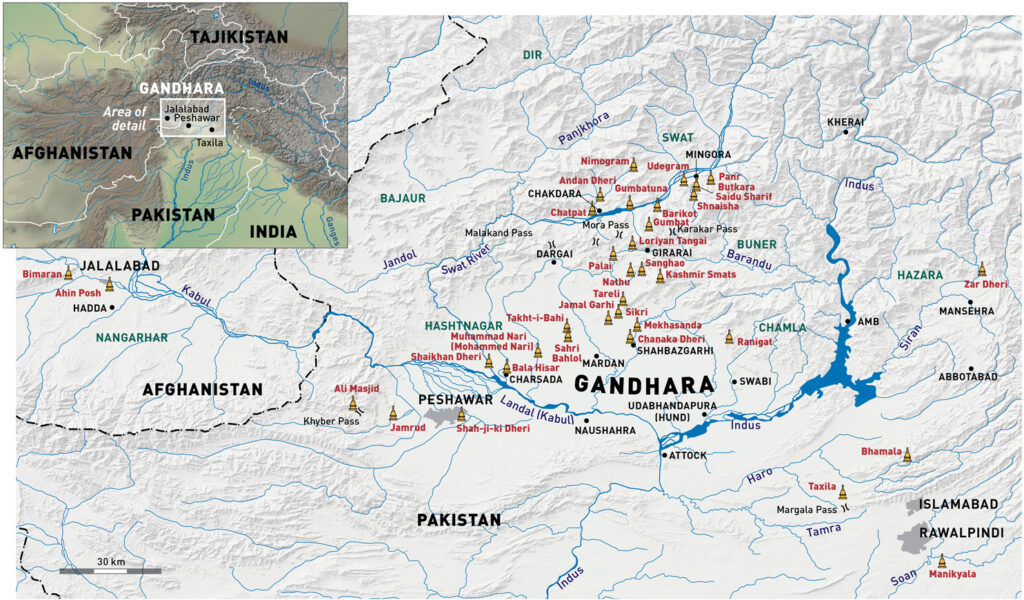
Credits: Asia Society
The map shows the area covered by the Gandhara Civilisation. It includes present day Pakistan, Northeast of Afghanistan and Southwest of China.
Greek Influences
Gandharan art can be traced to the 1st century BCE and includes painting, sculpture, coins, pottery, and all the associated elements of an artistic tradition. It took flight during the Kushan era especially under King Kanishka in the 1st century CE, who deified the Buddha and arguably introduced the Buddha image.
John Boardman characterizes Gandhara art as the culmination of Greek artistic traditions, particularly those of Classical and Hellenistic Greece. The artistic traditions of northwest India, which was successively ruled by the Seleucids, Bactrians, Parthians, Scythians, and Indo-Greeks, were deeply influenced by these Greek styles. The Indo-Greeks were influenced by the Greeks since they were exposed to so much of their culture, philosophy, art, and architecture. The artists that worked in Bactria also worked in Gandhara as well. We can see the influence of Greek artists on Indian sculptures in that region. As a result, Buddhist sculptors were either Greeks or learned from the Greeks. The same people worked in Bactria and Gandhara and we can see that by comparing the art on the coins because both places had the same Indo-Greek monarch.
Introduction to Gandharan Art
Gandharan art emerged around the 1st century BCE, combining diverse cultural influences from the region. This artistic style encompassed a range of mediums, including painting, sculpture, coins, and pottery, reflecting the area’s cultural diversity. The art form, particularly thrived during the Kushan era, especially under the reign of King Kanishka in the 1st century CE. Kanishka played a crucial role in deifying the Buddha and is believed to have introduced the first iconic representations of the Buddha.
Greek Influence on Gandharan Art
According to renowned historian John Boardman, Gandharan art represents the culmination of influential Greek artistic traditions, particularly from the Classical and Hellenistic periods. The region of northwest India, which was successively governed by the Seleucids, Bactrians, Parthians, Scythians, and Indo-Greeks, absorbed substantial Greek influences in art and culture. The Indo-Greeks, having been exposed to Greek culture, philosophy, art, and architecture, brought these elements to Gandhara. Furthermore, artists from the region of Bactria also contributed to the art of Gandhara, infusing it with Greek aesthetics, which can be seen in the area’s Buddhist sculptures.
Mythological Representations and Artistic Techniques
Gandharan art repeatedly showcases figures from Greek mythology, like the iconic Trojan Horse and the mighty Heracles. A defining feature of Classical Greek sculpture is its lifelike depiction of the human form, often intertwined with divine elements. As the scholar Ridgeway observed, “the driving force behind Greek monumental stone sculpture was essentially religious in nature.” This religious and artistic approach, when blended with Indian cultural themes, heavily shaped the evolution of Buddhist iconography, particularly through the emergence of humanlike portrayals of the Buddha. The fusion of Greek artistic principles with Indian religious imagery resulted in a unique style that left a lasting mark on regional artistic traditions.
Hellenistic Features in Gandharan Art
Gandharan art clearly shows the influence of Hellenistic styles. The figures are inspired by Greek models, with wavy hair and tight, pleated clothing.
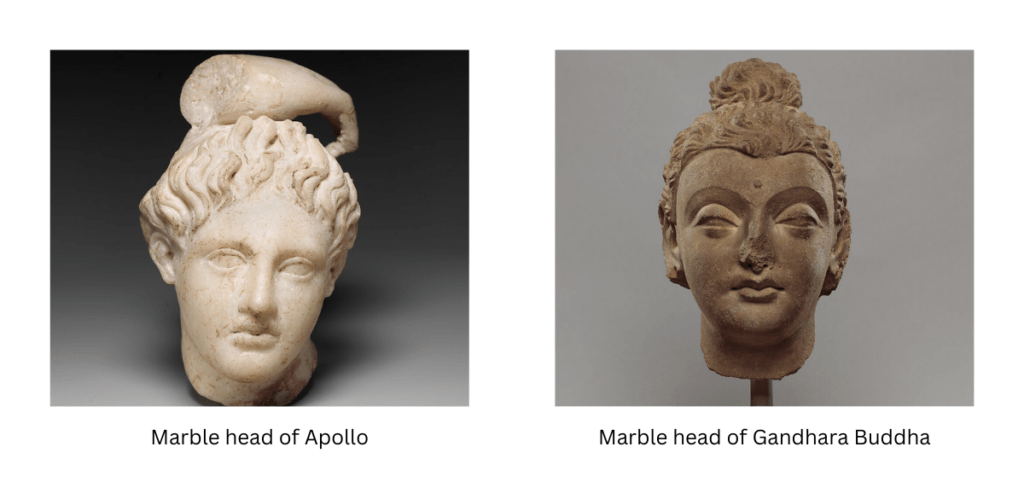
Credits: The Metropolitan Museum of Art
The ideal Hellenistic physique – slender and muscular, like a Greek athlete – was used for Buddha and Bodhisattva sculptures. Even the ushnisha on the Buddha’s head was based on Hellenistic hairstyles. And the nimbus or halo around the Buddha’s head is reminiscent of the imagery used for Greek sun gods, like Apollo.
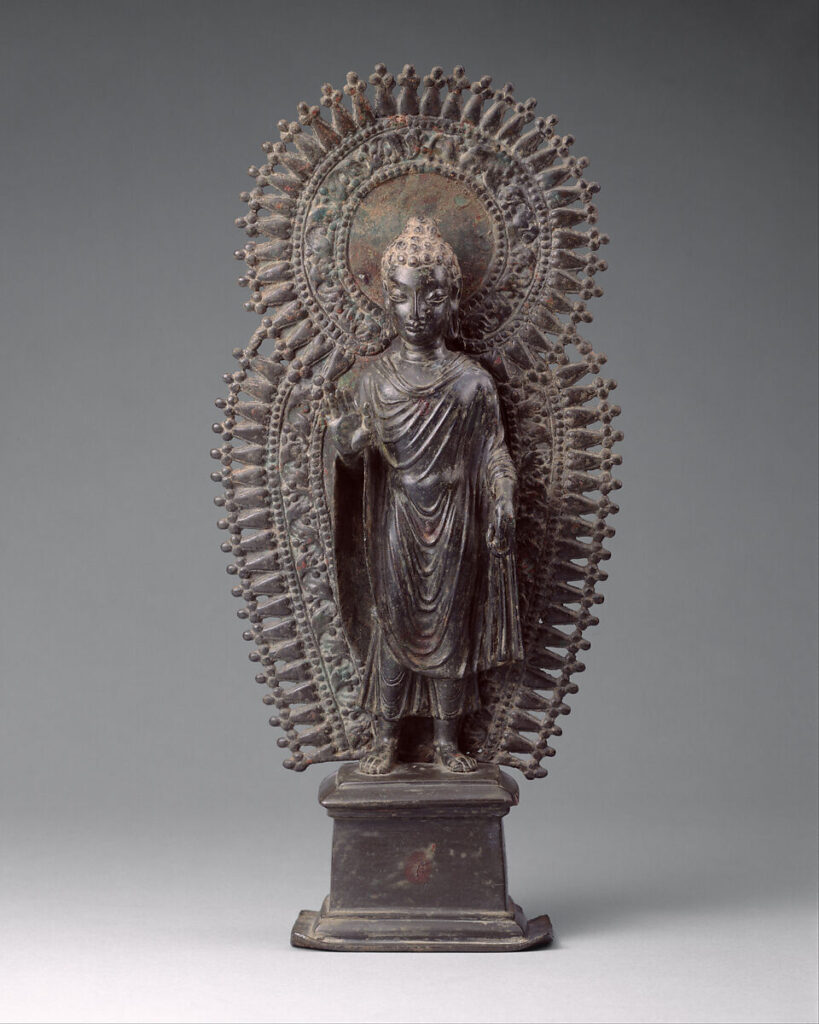
Credits: The Metropolitan Museum of Art
The Bodhisattva in Gandharan Art
In addition to representations of the Buddha, the Bodhisattva is a crucial part of Gandharan art. It symbolizes the Buddha before reaching enlightenment. Various Bodhisattvas from the Buddha’s past lives, like Avalokiteshvara, Maitreya, Padmapani, and Manjushri, are prominently featured in this artistic tradition. Unlike the simplicity of Buddha images, Bodhisattva sculptures and depictions are elaborately adorned, with jewelry, headdresses, robes, and footwear. This helps distinguish the different incarnations by their attire, postures, and symbolic mudras.
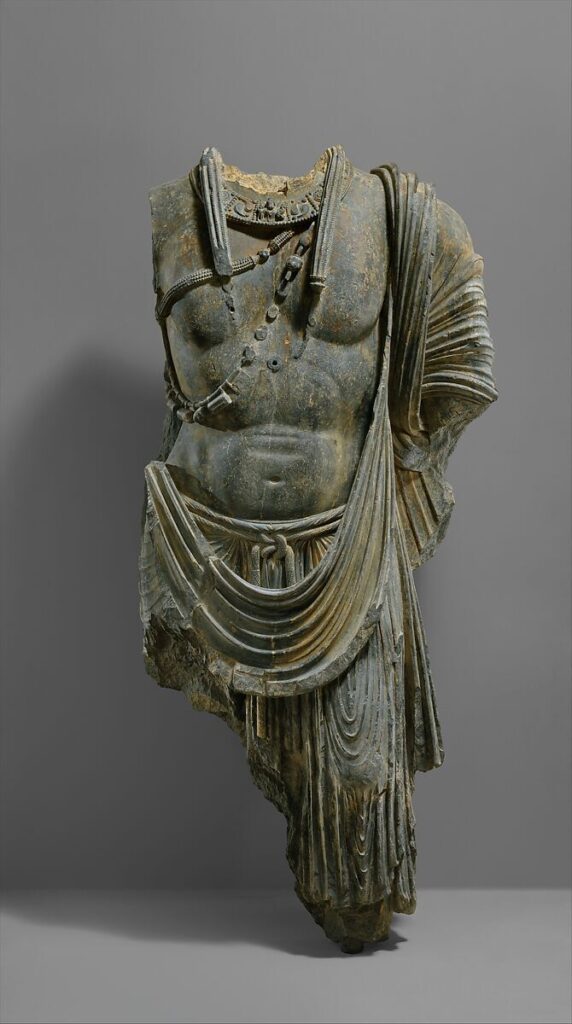
Credits: The Metropolitan Museum of Art
Evolution into a Hybrid Style
At first, Gandharan art was heavily influenced by the Hellenistic style. However, over time it blended with Indian visual elements, crafting a unique hybrid style known as the Gandhara style. While Greek artistic influence didn’t spread across all of India, it clearly had a significant impact on regional sculpture. Back in the 3rd century BCE, Buddhist sculptures didn’t depict the Buddha as a human. Rather, they used symbols like the Dharma Chakra, thrones, footprints, or the Bodhi tree. It was only later, during the Hellenistic period, that the Buddha started being represented in an iconic human form.
Bactrian Influence on Gandharan Art
Bactria’s influence on Gandharan art is pretty clear. Archaeologist J. Hackin shed light on how important Bactria was. However, its role wasn’t fully appreciated until later excavations uncovered a major Graeco-Iranian artistic tradition there. The stucco heads from Gandhara are super diverse and complex – some were molded, others sculpted freehand. They show a mix of styles, with a realistic, individualized touch that traces back to Hellenistic terracottas and Greek art. These stuccos, found in places like Hadda and Taxila, often depict minor gods, demons, and patrons, highlighting the artistic connections between the regions.
Even though we don’t have tons of Graeco-Bactrian art and the timelines are murky, it’s obvious Bactria and Gandhara were closely linked. Some Bactrian sculptures act as a vital bridge between late Hellenistic art and Gandharan sculpture. They prove how intertwined these traditions were. Gandharan art blended Greek, Roman, Parthian, and Bactrian influences to create a unique style that still captivated scholars.
Important Archaeological Sites of Gandhara
Taxila: A World Heritage Site and Cultural Treasure
Taxila, located in Pakistan’s Punjab province, is a UNESCO World Heritage site that’s famous for its rich history. This old city is filled with all kinds of historic buildings, fortified towns, stupas, and monasteries. These display a mix of foreign influences in their art and architecture. From the 2nd century BCE to the 5th century CE, Taxila was an important hub for Buddhist education. It attracted scholars and monks from around the region to study Buddhist education. Many of the iconic Gandharan sculptures and artifacts have been discovered here over the years.
One of the most remarkable sites in Taxila is the Dharamrajika Stupa. People say that it contained the Buddha’s original relics. This place is full of Buddhist art, with loads of stone and stucco statues of the Buddha. Plus, the stupa has panels showing important moments from the Buddha’s life. So, it’s a crucial spot for learning about how Buddhism spread through the region.
Chakdara: A Historical Site
Chakdara, a site with a multi-millennial history, is another significant location near Taxila. It is dotted with archaeological remains from the Gandhara burial culture, Buddhist structures, and Hindu Shahi fortifications. This highlights its enduring importance within the regional historical narrative. Chakdara’s archaeological abundance offers invaluable insights into the diverse cultural and religious forces that have shaped the area over the course of centuries.
Charsadda: The Capital of Ancient Gandhara
Charsadda, the former capital of the Kingdom of Gandhara, was a historically significant city. Around 516 BCE, Gandhara was incorporated into the seventh satrapy, or province, of the Achaemenid Persian Empire, and its people paid tribute to Darius the Great. This status persisted until the region was conquered by Alexander the Great in the 4th century BCE. This marked another pivotal chapter in Gandhara’s rich and diverse history. As the capital city, Charsadda’s historical importance and connections to major ancient empires underscore its central role in ancient Gandhara.
Conclusion
Today, Gandhara sculptures are not limited to Pakistan’s national and local museums. They are prominently displayed in prominent international art institutions across the Far East, Australia, Europe, and North America. Musée Guimet, the Berlin Museum, the Victoria and Albert Museum, the British Museum, the MET, and the Oriental Institute all house exceptional examples of Gandhara art. This widespread global interest is a testament to the authentic beauty and enduring appeal of Gandhara sculpture. It captivates art enthusiasts worldwide much like the renowned pottery of ancient Greece and the art of ancient Egypt.
